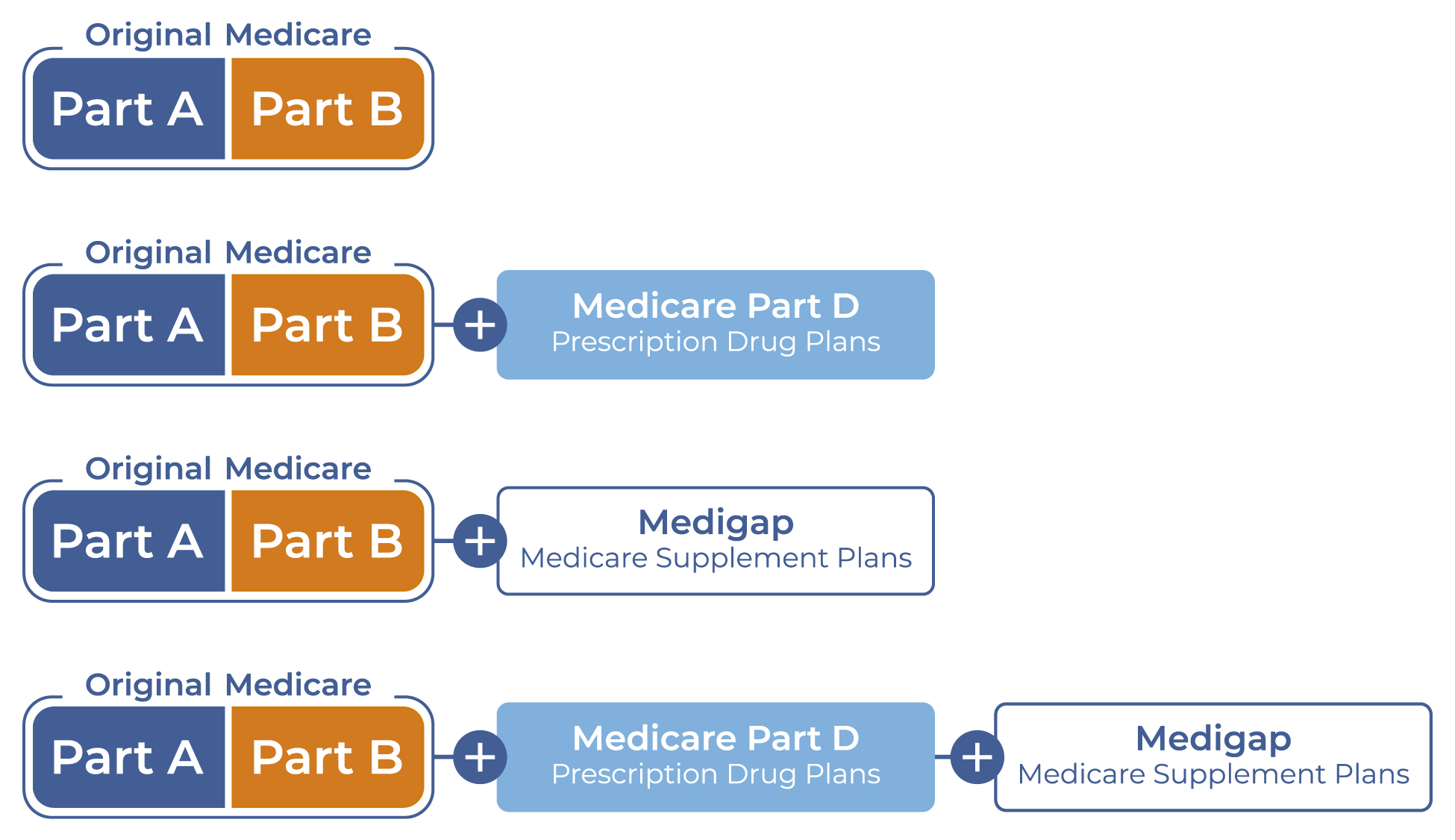
Understanding Medicare Guide
The quick and easy guide to understanding the Medicare options available to you.
Medicare Defined
What is Medicare?
Medicare is a government sponsored program that provides medical coverage for people 65 and older. People who are under 65 may be eligible for Medicare if they have certain disabilities.
The next few pages will explore each part of Medicare and highlight the options available to you. When you get to the end of this guide, you will have a better understanding of Medicare and the available options, so you can make a more thoughtful decision on the best plan for your situation.
Terms You Should Know
Premium - the amount you pay each month for your health plan to Medicare, a private insurance company, or both, depending on your coverage.
Deductible - the amount that you pay out of pocket for covered services before your plan begins to pay.
Copayment (Copay) - the set fee you pay when you visit your doctor or fill a prescription. For example, you might pay $12 when you fill a prescription.
Coinsurance - the percentage of the cost you pay for a covered service. For example, you might pay 20% and your plan would pay 80%.
Out-of-Pocket Maximum - the total amount you might pay during a calendar year. After you reach your out-of-pocket maximum, your plan pays 100% of the allowed amount for covered services.
As you review your options, it’s easy to focus on premiums as they are a regular monthly expense. However, depending on your needs, a plan with a low monthly premium might end up costing you more based on the deductible, copays, or out-of-pocket maximum. It’s a smart idea to look at the full scope of the available plans.
Medicare has Four Parts
Part A - Hospital Insurance
Part B - Medical Insurance
Part C - Medicare Advantage Plans
Part D - Prescription Drug Converage
Medigap - Medicare Supplement Plans
The Parts of Medicare
Original Medicare
Medicare Part A + Medicare Part B
Medicare Part A works in conjunction with Medicare Part B. The two are often referred to as Original Medicare.
Medicare Part A: Hospital Insurance
What it Covers:
Hospital Stays
Home Health Care
Hospice Care
Skilled Nursing Facilities
Your Extra Costs:
Deductibles
Copays
Coinsurance
Medicare Part B: Medical Insurance
What it Covers:
Outpatient Procedures
Doctor Visits
Lab Testing
Ambulance Rides
Your Extra Costs:
Annual Deductibles
Monthly Premiums
Coinsurance
Original Medicare covers a lot of the health care you may need, but it doesn’t cover everything. If you only have Medicare Part A and Part B, you will pay the full costs for many services not covered by Original Medicare:
Prescription drugs you take at home
Dental care & most dental services
Routine eye exams & eyeglasses
Routine hearing exams & hearing aids
Routine physical exams
Transitional care in a skilled nursing facility without a qualifying 3-day hospital stay
Most care you receive when traveling outside the U.S.
Adding Private Plans to Improve Coverage
Your healthcare needs are personal.
When it comes to supplementing your Medicare plan with private insurance, you have two options: the first option is known as Supplemental Coverage. It is made up of several parts and you have the choice to add or omit additional coverage like Medigap or Part D. Your second option is Medicare Part C (Medicare Advantage Plans). This is essentially your one-stop-shop for Medicare coverage. Let’s continue to learn about each part of your two Medicare options.
Medicare Part C: Medicare Advantage Plans
What it Covers:
Medicare Part A & Part B Benefits
Most plans include Medicare Part D (prescription drug coverage)
Some plans also cover dental, vision, & hearing
Your Extra Costs:
Annual Deductibles
Monthly Premiums
Coinsurance
Copays
These plans often offer more coverage than Original Medicare at a lower cost. This is possible because these plans are made up of network providers.
Medicare Part D: Prescription Drug Insurance
What it Covers:
Prescription Drugs
Your Extra Costs:
Annual Deductibles
Copays
Coinsurance
Monthly Premiums
Medigap: Medicare Supplement Plans
What it Covers:
Helps fill the “gaps” in
Original Medicare
Can reduce out-of-pocket costs
Your Extra Costs:
Premiums
What Are My Options?
So which plan is right for you?
Take a few minutes to look over the following charts to get a better understanding of what your two Medicare options offer. While each individual plan differs, this is a good, general overview.
Option One: Original Medicare
You have the option to add Part D, Medigap, or both to Original Medicare.
Option Two: Medicare Advantage Plans
Your second option is to receive Medicare benefits through a Medicare Advantage plan (Part C). Most plans come with prescription drug coverage. You may have the option to add a stand-alone Part D plan to certain Medicare Advantage plan types.
Comparing Medicare Supplement & Medicare Advantage
Original Medicare + Medigap
Freedom to choose doctors and hospitals (as long as they accept Medicare patients.)
Medicare Advantage Plans
You may be limited to doctors and hospitals within your plan network.
Original Medicare + Medigap
No referral is needed to be seen by a specialist.
Medicare Advantage Plans
A referral may be needed to be seen by a specialist. You may be limited to specialists within your plan network.
Original Medicare + Medigap
There are no network restrictions.
Medicare Advantage Plans
There may be network restrictions. Domestic emergency care is covered and international visits may be covered.
Original Medicare + Medigap
Apply any time after you turn 65 and have joined Medicare Part B.
Medicare Advantage Plans
You may be limited to enrolling (or switching plans) during certain times of the year.
Original Medicare + Medigap
You pay your Part B premium and a monthly plan premium. Out-of-pocket costs are limited.
Medicare Advantage Plans
Generally, you pay a low monthly premium plus your Medicare premium. You may pay co-insurance, co-pays, and deductibles. Out-of-pocket costs are limited.
Original Medicare + Medigap
There is no prescription drug coverage. Purchase a Medicare Part D plan for prescription drug coverage.
Medicare Advantage Plans
Most plans offer prescription drug coverage.
Original Medicare + Medigap
Does not cover vision, hearing aids, or dental care.
Medicare Advantage Plans
Vision, hearing aids, and dental care, plus other healthy living extras, are included in some plans.
Med City Medicare makes it easy to get free, unbiased advice.
Schedule a consultation
Receive a free review
Get the best plan for you




















